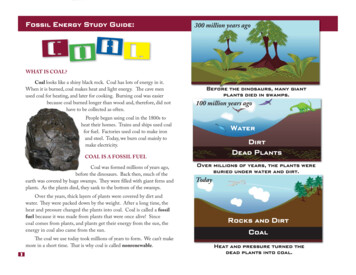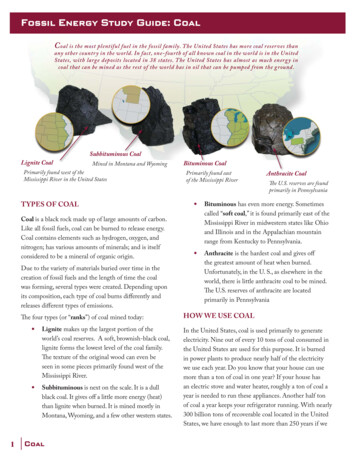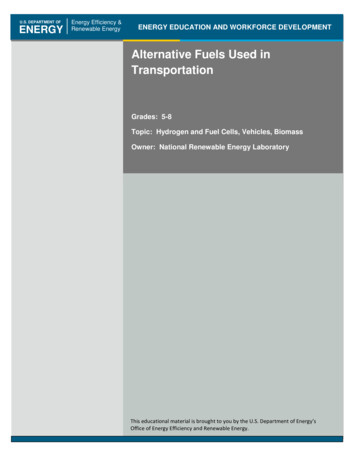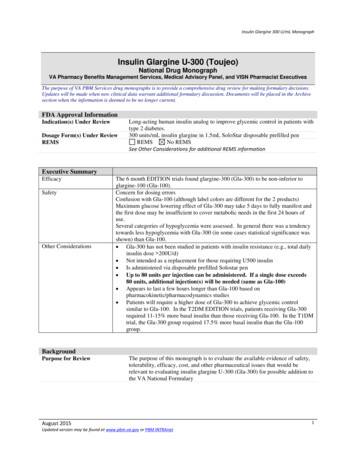
Transcription
Fossil Energy Study Guide:300 million years agoWHAT IS COAL?Coal looks like a shiny black rock. Coal has lots of energy in it.When it is burned, coal makes heat and light energy. The cave menused coal for heating, and later for cooking. Burning coal was easierbecause coal burned longer than wood and, therefore, did nothave to be collected as often.Before the dinosaurs, many giantplants died in swamps.100 million years agoPeople began using coal in the 1800s toheat their homes. Trains and ships used coalfor fuel. Factories used coal to make ironand steel. Today, we burn coal mainly tomake electricity.WaterDirtDead PlantsCOAL IS A FOSSIL FUELCoal was formed millions of years ago,before the dinosaurs. Back then, much of theearth was covered by huge swamps. They were filled with giant ferns andplants. As the plants died, they sank to the bottom of the swamps.Over the years, thick layers of plants were covered by dirt andwater. They were packed down by the weight. After a long time, theheat and pressure changed the plants into coal. Coal is called a fossilfuel because it was made from plants that were once alive! Sincecoal comes from plants, and plants get their energy from the sun, theenergy in coal also came from the sun.The coal we use today took millions of years to form. We can’t makemore in a short time. That is why coal is called nonrenewable.Over millions of years, the plants wereburied under water and dirt.TodayRocks and DirtCoalHeat and pressure turned thedead plants into coal.
Fossil Energy Study Guide: CoalCOAL IS OUR MOST ABUNDANT FUELThe United States has more coal reserves than any other country inthe world. In fact, one-fourth of all the known coal in the world is in theUnited States. The United States has more coal that can be mined thanthe rest of the world has oil that can be pumped from the ground. Wehave enough to last more than 250 years!Currently, coal is mined in 25 of the 50 states.keyCoal is used primarily in the United States to generate electricity.In fact, it is burned in power plants to produce more than half of theelectricity we use. A stove uses about half a ton of coal a year. A waterheater uses about two tons of coal a year. And a refrigerator, that’sanother half-ton a year. Even though you may never see coal, you useseveral tons of it every year!Coal is not only our most abundant fossil fuel, it is also the one withperhaps the longest history.
Fossil Energy Study Guide: CoalA BRIEF HISTORY OF COALCoal is the most plentiful fuel in the fossil family and it has thelongest and, perhaps, the most varied history. Coal has been used forheating since the cave man. Archeologists have also found evidence thatthe Romans in England used it in the second and third centuries (100200 AD).In the 1700s, the English found that coal could produce a fuel thatburned cleaner and hotter than wood charcoal.During the 1300s in North America, the Hopi Indians used coal forcooking, heating and to bake the pottery they made from clay. Coal waslater rediscovered in the United States by explorers in 1673.The Industrial Revolution played a major role in expanding theuse of coal. A man named James Watt invented the steam engine whichmade it possible for machines to do work previously done by humansand animals. Mr. Watt used coal to make the steam to run his engine.During the first half of the 1800s, the Industrial Revolution spreadto the United States. Steamships and steam-powered railroads weremain forms of transportation, and they used coal to fuel their boilers.In the second half of the 1800s, more uses for coal were found.During the Civil War, weapons factories were beginning to use coal.By 1875, coke (which is made from coal, and is not the same as CocaCola!) replaced charcoal as the primary fuel for iron blast furnaces tomake steel.The burning of coal to generate electricity is a relative newcomer inthe long history of this fossil fuel. It was in the 1880s when coal was firstused to generate electricity for homes and factories. By 1961, coal hadbecome the major fuel used to generate electricity in the United States.Long after homes were being lighted by electricity produced bycoal, many of them continued to have furnaces for heating and some hadstoves for cooking that were fueled by coal.Today we use a lot of coal, primarily because we have a lot of it andwe know where it is in the United States.
Fossil Energy Study Guide: CoalCOAL MINING AND TRANSPORTATIONMost coal is buried under the ground. If coal is near the surface,miners dig it up with huge machines. First, they scrape off the dirt androck, then dig out the coal. This is called surface mining.After the coal is mined, they put back the dirt and rock. Theyplant trees and grass. The land can then be used again. This is calledreclamation.If the coal is deep in the ground, tunnels called mine shafts are dugdown to the coal. Machines dig the coal and carry it to the surface.Some mine shafts are 1,000 feet deep. This is called deep mining, orunderground mining.We Dig for CoalIn the mine, coal is loaded in small coal cars or on conveyor beltswhich carry it outside the mine to where the larger chunks of coal areloaded into trucks that take it to be crushed (smaller pieces of coal areeasier to transport, clean, and burn).The crushed coal can then be sent by truck, ship, railroad, or barge.You may be surprised to know that coal can also be shipped by pipeline.Crushed coal can be mixed with oil or water (the mixture is called aslurry) and sent by pipeline to an industrial user.
Fossil Energy Study Guide: CoalCONVERTING COAL INTO ELECTRICITYNine out of every 10 tons of coal mined in the United States todayare used to make electricity, and nearly half of the electricity used in thiscountry is coal-generated electricity.The process of converting coal into electricity has multiple stepsand is similar to the process used to convert oil and natural gas intoelectricity:1.A machine called a pulverizer grinds the coal into a finepowder.2.The coal powder mixes with hot air, which helps the coal burnmore efficiently, and the mixture moves to the furnace.We use coal-generated electricity for:3.The burning coal heats water in a boiler, creating steam. heating,4. cooling,Steam from the boiler spins the blades of an engine called aturbine, transforming heat energy from burning coal intomechanical energy that spins the turbine engine. cooking, lighting, transportation, communication, farming, industry, healthcare, and much more!Electricity from coal is the electric power made from the energystored in coal. Carbon, made from ancient plant material, gives coalmost of its energy. This energy is released when coal is burned.Turning Coal intoElectricity5.The spinning turbine is used to power a generator, amachine that turns mechanical energy intoelectric energy. This happens whenmagnets inside a copper coil in thegenerator spin.6.A condenser cools the steam movingthrough the turbine. As the steam iscondensed, it turns back into water.7.The water returns to the boiler, and thecycle begins again.The steps for converting coal into electricityare shown here, and described above. An actualphoto of a turbine is shown in the circle.Turbines have fan-like blades attached to a shaftthat spin to generate power. Practically everyform of electric power is generated by a turbine.Even the Space Shuttle uses a gas turbine!
Fossil Energy Study Guide: CoalDELIVERING ELECTRICITYElectricity-generating plants send out electricity using atransformer, which changes the electricity from low voltage to highvoltage. This is an important step, as it gives electricity the jolt it needsto travel from the power plant to its final destination. Voltages are oftenas high as 500,000 volts at this point.Electricity flows along transmission lines to substationtransformers. These transformers reduce the voltage for use in the localareas to be served.delivery process is instantaneous. By the time you have flipped a switchto turn on a light, electricity has been delivered.COAL’S ROLE IN OUR ELECTRICAL SUPPLYNatural gas and oil are also used to make electricity. How does coalcompare to these other fossil fuels? In terms of supply, coal has a clearadvantage. The United States has nearly 300 billion tons of recoverablecoal. That is enough to last more than 250 years if we continue to usecoal at the same rate as we use it today.But what about costs? The mining, transportation, electricitygeneration, and pollution-control costs associated with using coal areincreasing, but both natural gas and oil are becoming more expensive touse as well. This is, in part, because the United States must import muchof its oil supply from other countries. It has enough coal,however, to take care of its electricity needs, with enoughTransformer changesleft over to export some coal as well.the voltage of electricityHIGWLOHFrom the substation transformers, electricity travels alongdistribution lines, which can be either above or below the ground, tocities and towns. Transformers once again reduce the voltage—this timeto about 120 to 140 volts—for safe use inside homes and businesses. TheTransmission linescarry electricitylong distancesElectricity-generating plants sendout electricityHow ElectricityGets to Your HouseDistribution linescarry electricityto your houseThe cost of using coal should continue to be evenmore competitive, compared with the rising cost of otherfuels. In fact, generating electricity from coal is cheaperthan the cost of producing electricity from natural gas.In the United States, 23 of the 25 electric power plantswith the lowest operating costs use coal. Inexpensiveelectricity, such as that generated by coal, means loweroperating costs for businesses and for homeowners. Thisadvantage can help increase coal’s competitiveness in themarketplace.
Fossil Energy Study Guide: CoalCLEANING UP COALCoal is our most abundant fossil fuel. The United States hasmore coal than the rest of the world has oil. There is still enough coalunderground in this country to provide energy for the next 250 years ormore.But coal is not a perfect fuel.Trapped inside coal are traces of impurities like sulfur and nitrogen.When coal burns, these impurities are released into the air.While floating in the air, these substances can combine with watervapor (for example, in clouds) and form droplets that fall to earth asweak forms of sulfuric and nitric acid. Scientists call it “acid rain.”There are also tiny specks of minerals—including common dirt—mixed in coal. These tiny particles don’t burn and make up the ash leftbehind in a coal combustor. Some of the tiny particles also get caughtup in the swirling combustion gases and, along with water vapor, formthe smoke that comes out of a coal plant’s smokestack. Some of theseparticles are so small that 30 of them laid side-by-side would barelyequal the width of a human hair!Also, coal like all fossil fuels is formed out of carbon. All livingthings—even people—are made up of carbon. (Remember—coal startedout as living plants.) But when coal burns, its carbon combines withoxygen in the air and forms carbon dioxide. Carbon dioxide is a colorless,odorless gas, but in the atmosphere, it is one of several gases that cantrap the earth’s heat. Many scientists believe this is causing the earth’stemperature to rise, and this warming could be altering the earth’s climate.Sounds like coal is a dirty fuel to burn. Many years ago, it was.But things have changed. Especially in the last 20 years, scientists havedeveloped ways to capture the pollutants trapped in coal before they canescape into the air.We also have new technologies that cut back on the release of carbondioxide by burning coal more efficiently.Many of these technologies belong to a family of energy systemscalled “clean coal technologies.”HOW DO YOU MAKE COAL CLEANER?Actually there are several ways.One way is to clean the coal before it arrives at the power plant. Thisis done by simply crushing the coal into small chunks and washing it.Another way is to use “scrubbers” that remove the sulfur dioxide (apollutant) from the smoke of coal-burning power plants.
Fossil Energy Study Guide: CoalHOW DO SCRUBBERS WORK?THE CLEANEST COAL TECHNOLOGY —A REAL GAS!Most scrubbers rely on a very common substance found in naturecalled “limestone.” We literally have mountains of limestone throughoutthe United States. When crushed and processed, limestone can be madeinto a white powder. Limestone can be made to absorb sulfur gasesunder the right conditions—much like a sponge absorbs water.We can even turn coal into a gas—using lots of heat and water—ina process called gasification. When coal is turned into a gas, we canburn it and use it to spin a gas turbine to generate electricity. The exhaustgases coming out of the gas turbine are hot enough to boil water tomake steam that can spin another type of turbine to generate even moreelectricity. But why go to all the trouble to turn the coal into gas if allyou are going to do is burn it?In most scrubbers, limestone (or another similar material calledlime) is mixed with water and sprayed into the coal combustion gases(called “flue gases”). The limestone captures the sulfur and “pulls” it outof the gases. The limestone and sulfur combine with each other to formeither a wet paste (it looks like toothpaste!), or in some newer scrubbers,a dry powder. In either case, the sulfur is trapped and prevented fromescaping into the air.A big reason is that the pollutants in coal—like sulfur, nitrogenand carbon dioxide —can be almost entirely cleaned up when coal ischanged into a gas. In fact, scientists have ways to remove 99.9 percentof the sulfur and small dirt particles from coal gas. Gasifying coal is oneof the best ways to clean pollutants out of coal.Another reason is that the coal gases don’t have to be burned. Theycan also be used as valuable chemicals. Scientists have developed ways toturn coal gases into everything from liquid fuels for cars and trucks toplastic toothbrushes!
Fossil Energy Study Guide: CoalCOAL AND CLIMATE CHANGECarbon dioxide (CO2) is a colorless, odorless gas that is producednaturally when humans and animals breathe. The main source of manmade CO2 emissions, however, is the burning of fossil fuels (oil, naturalgas and coal) for energy production. Carbon dioxide is importantfor plants and animals, but if too much of it is produced, it can buildup in the air and trap heat near the earth’s surface. This is called thegreenhouse effect.To clean CO2 from power plants, scientists have been studying howto capture the CO2 coming up a power plant’s smokestack before itgets into the air. The CO2 can then gathered, transported, and eventuallystored deep underground or in the ocian, where it’s supposed to sit for along, long time. Scientists are even studying ways to recycle the CO2 intonew materials. The technical name for this process is carbon capture andstorage, or carbon sequestration.It is expected that coal and other fossil fuels will remain a majorenergy source for years to come. Many environmentalists believe thatcapturing and storing CO2 from power plants, combined with otherefforts, could help fight climate change.Scientists continue to research and develop carbon sequestrationtechnologies. It is important to make sure these new processes areenvironmentally acceptable and safe. For example, scientists mustdetermine that CO2 will not escape from under the ground, orcontaminate drinking water supplies. Carbon capture and storage is anexciting area of research and development for today’s scientists.CARBON STORAGECO2
A BRIEF HISTORY OF COAL Coal is the most plentiful fuel in the fossil family and it has the longest and, perhaps, the most varied history. Coal has been used for heating since the cave man. Archeologists have also found evidence that the Romans in Englan










